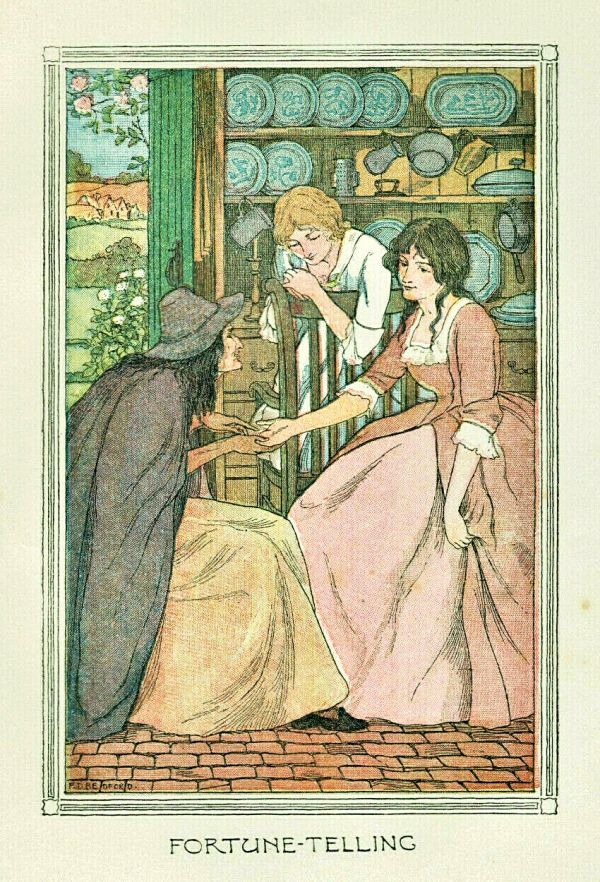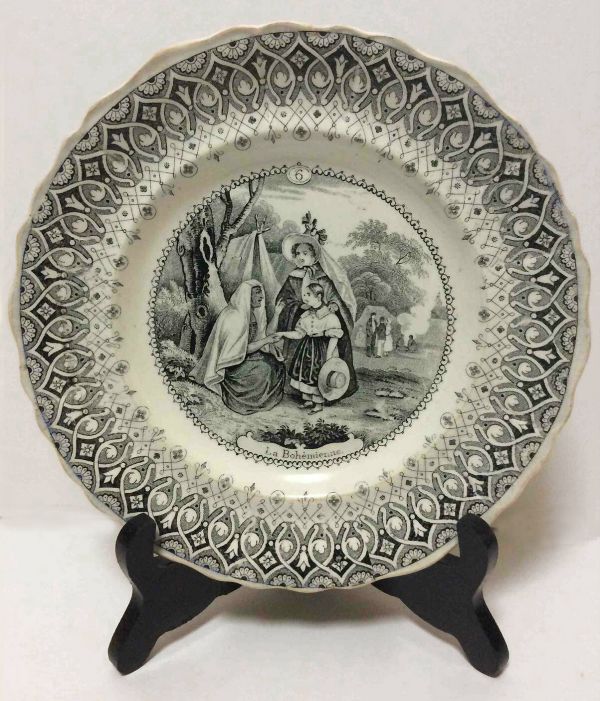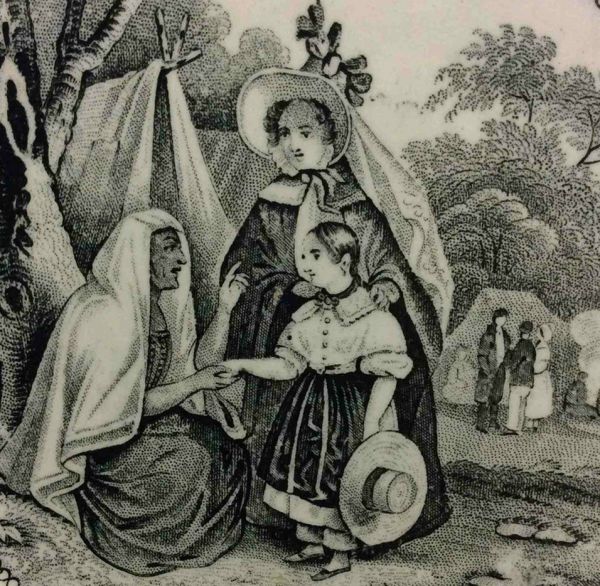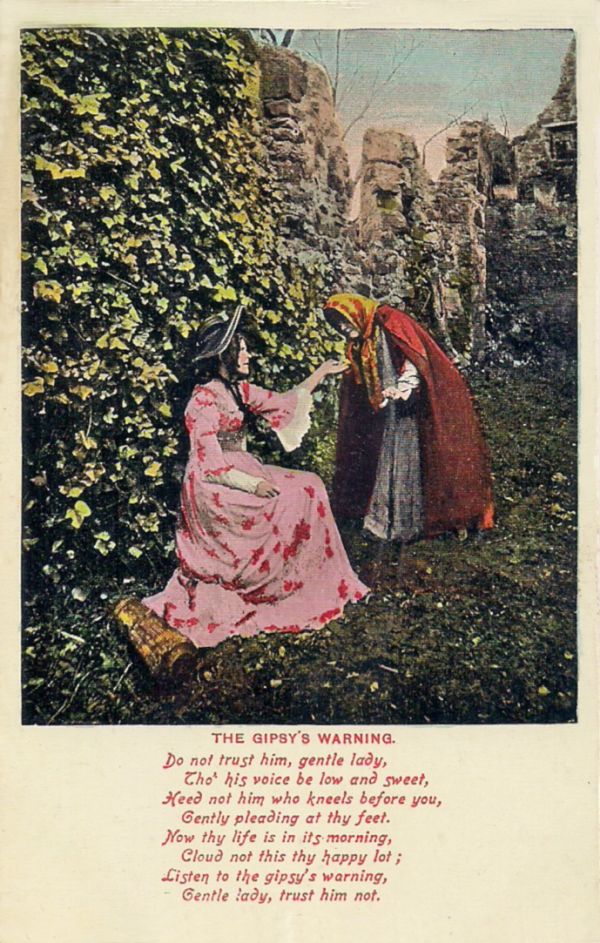Palmistry and Palm Readers: Difference between revisions
No edit summary |
No edit summary |
||
| Line 39: | Line 39: | ||
[[File:Book-Illo-Palmistry-Fortune-Telling-By-F-D-Bedford-c-1920.jpg|thumb|600px|center|"Fortune Telling," a book illustration by F. D. Bedford, circa 1920, in which the "gypsy witch" has left the outdoors domain of the Bohemian Romani woman and entered into the domestic kitchen of those to whom she issues her frightening prophesies. The clothing, 19th century in style, tells us that the artist conceived this as a tale of the romantic past.]] | [[File:Book-Illo-Palmistry-Fortune-Telling-By-F-D-Bedford-c-1920.jpg|thumb|600px|center|"Fortune Telling," a book illustration by F. D. Bedford, circa 1920, in which the "gypsy witch" has left the outdoors domain of the Bohemian Romani woman and entered into the domestic kitchen of those to whom she issues her frightening prophesies. The clothing, 19th century in style, tells us that the artist conceived this as a tale of the romantic past.]] | ||
Meanwhile, | |||
Likewise, in India, palmistry persisted as a well-known and culturally approved form of character analysis and predictive art. With the 19th century, the terms "scientific palmistry" and "medical palmistry" began to be applied to palm reading, in keeping with its obvious connections to physical traits, and these terms were piked up by English-peaking Indians as they served the well-to-do and politically prominent. | |||
This four-page flyer, printed in Bombay (now Mumbai), India in 1940, shows how respectable and normal pal reading was in India, at a time when American palm readers often were treated as outsiders and frauds. | This four-page flyer, printed in Bombay (now Mumbai), India in 1940, shows how respectable and normal pal reading was in India, at a time when American palm readers often were treated as outsiders and frauds. | ||
| Line 49: | Line 51: | ||
By the time that genetics entered the picture | By the time that genetics entered the palmistry picture in the late 20th century, the concept of "scientific palmistry" and "medical palmistry" was finally accepted, and the idea that palm reading, a much-maligned form of fortune telling had held and preserved so many interesting genetic markers served to remove some of the stigma from its traditional practice in Europe and America. | ||
Revision as of 02:46, 16 September 2021
In this installment of "Your Wate and Fate," we take a sneak-peek look at an upcoming page that will eventually be on display to the public. As a Patreon supporter, you have access to the page one full year before the public does.
- Patreon Release Date: September 15th, 2021
- Public Release Date: September 15th, 2022.
Please tell your friends that they can subscribe to my Patreon stream for $2.00 per week:
To discuss this and other Your Wate and Fate pages with me, join my private Patreon Forum here:
As a form of divination, palmistry combines character analysis with fortune telling. Most readers consider it to be one of the more scientific forms of prediction, because a great many of the features of the hand are determined by genetics, including the presence of congenital diseases and the likelihood of the sitter following a career that an ancestor also pursued.
As far as i can tell, the scientific study of palm reading began or became widely popular in India, centuries ago. It travelled to Europe with the Romani people, who date their movement westaward to the time of Alexander the Great, and still maintain many Indian customs and beliefs.
Hand reading was soon associated with Romani practitioners in Eastern Europe. As these people, wrongly called "Gypsies" by Europeans who thought that they had come from Egypt, moved Westward into Europe and Great Britain, they actually brought two popular forms of fortune telling with them — palm reading and fortune telling with birds. Both of these were practiced in public, by women, the Romani men being mostly horse trainers, dealers, and brokers, a hereditary trade in their culture, and a vital part of their nomadic lifestyle. That nomadic life, which led to their unaccountability to local authorities, also led to discrimination against the Romani, and an othering of their way of life. Words like mysterious, exotic, strange, and weird were attached to them.
Eventually, because so many settled in the region then known as Bohemia (now the Czech Republic), they came to be known as Bohemians, a word that, in turn, came to mean anyone, from any culture or region, who chooses to live outside of society's conventional norms. The Bohemian lifestyle was one of freedom, eccentricity, and reduced accountability to the capitalist state. These days the derivative fashion term Boho refers to garments that are free flowing, with long skirts and full sleeves, resembling the clothes of the 19th century Romani in Bohemia.
Some of the first experiences Americans and Europeans had with palmistry as a form of character analysis or fortune telling was with Romani women who read their hands. In the 19th century, the Romani were forbidden to set up shops or permanent dwellings, and lived in camps outside of towns, coming in to trade at towns during feast days, market days, and fairs. The bolder seekers after fortunes would ride or walk out to the "Gypsy camp" to have their futures told.
The image of the uncanny, frightening :"Gypsy woman" who reads the hand and makes dire predictions reached a height in Briirtain and America during the late Victorian era and continued well on into the 20th century. A common topic for postcards, the image was usually that of a young Anglo woman having her hand read by an old Romani woman, out of doors, either amidst ruins or near a campsite.
In time, the elderly Romani woman began to fuse with the English and American stereotype of "the witch," a hook-nosed woman who wore clothes similar to Welsh villagers and who was thought to have evil intentions toward more culturally normative women. The "gypsy witch" competed with the "Bohemenian gypsy" as a stereotype for decades.

Meanwhile,
Likewise, in India, palmistry persisted as a well-known and culturally approved form of character analysis and predictive art. With the 19th century, the terms "scientific palmistry" and "medical palmistry" began to be applied to palm reading, in keeping with its obvious connections to physical traits, and these terms were piked up by English-peaking Indians as they served the well-to-do and politically prominent.
This four-page flyer, printed in Bombay (now Mumbai), India in 1940, shows how respectable and normal pal reading was in India, at a time when American palm readers often were treated as outsiders and frauds.
By the time that genetics entered the palmistry picture in the late 20th century, the concept of "scientific palmistry" and "medical palmistry" was finally accepted, and the idea that palm reading, a much-maligned form of fortune telling had held and preserved so many interesting genetic markers served to remove some of the stigma from its traditional practice in Europe and America.



